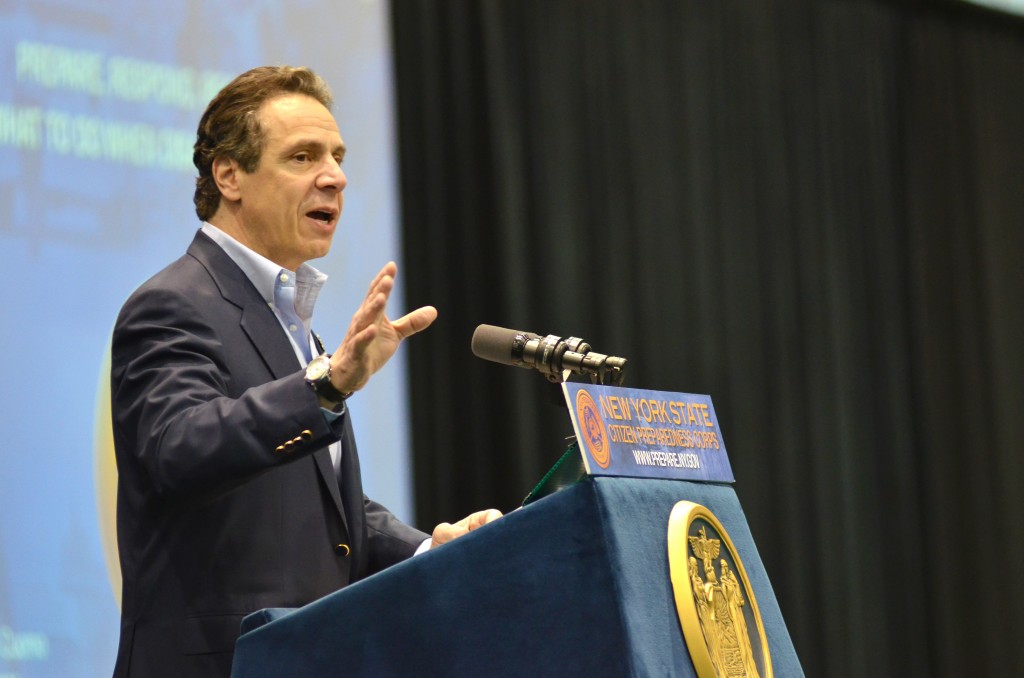
Gov. Andrew Cuomo visited Binghamton University Saturday to spread his message of “prepare, respond and recover.”
The event was part of a series of Citizen Preparedness Corps Training Programs organized by the governor’s office in conjunction with the New York Army National Guard and the Department of Homeland Security and Emergency Services. The courses were designed to give citizens the basic tools and knowledge to respond in the event of a disaster, with the goal of training 100,000 New Yorkers this year.
Gov. Cuomo said emergency preparedness is an increasingly important concern in New York state.
“There is a new pattern of extreme weather that we have never seen before,” Cuomo said. “I’ve been governor three years, and we have had nine federally declared disasters in three years.”
Nearly 500 people attended the workshop, which was held in the Events Center Saturday morning. Speakers noted the special significance of emergency preparation to Broome County after the damage that was incurred during massive flooding in 2006 and 2011.
“The people who are here today are very excited because I’m sure many of them experienced a loss of personal value in their homes during the floods of ‘06 and ‘11,” said New York State Sen. Thomas Libous. “Preparedness is something we have to do in the Southern Tier, and I think this is going to go a long way.”
Cuomo attributed some of the damage in 2011 to misallocation of resources resulting from incomplete information.
According to Cuomo, models predicted that Tropical Storm Irene would hit New York City, so when the storm moved north to upstate New York, officials found themselves ill-prepared for the flooding.
Money has been allocated in the 2014 Executive Budget to plans to buy a state-of-the-art weather tracking system that Cuomo said will be the most advanced in the country.
Broome County Executive Debra Preston detailed a two-pronged plan to better prepare the area for the next storm. Broome County officials worked with the state government to create a disaster supply center at the Greater Binghamton Airport, and are currently in contact with the federal government in order to purchase part of the former Army Depot in the Town of Fenton for use as a shelter to house displaced people in the event of a disaster.
“We worked hard to get a regional disaster supply center at the Greater Binghamton Airport. It is one of only nine in the state which houses supplies people would need during a flood including generators, food, water, pumps and portable lights,” Preston said.
Trainees were advised to sign up for local alert systems, which officials can use to send out mass information during a disaster, and were directed to a new website, prepare.ny.gov, for advice.
Other parts of the presentation focused on the aftermath of a disaster situation, like providing sufficient food and water for everyone in the family. Major General Patrick Murphy advocated for using dehydrated food rather than canned food, which can expire. He reminded attendees to continuously rotate out canned items to avoid having only expired rations in case of emergency, and reminded everyone to provide one gallon of water per day per person.
“In the event of a disaster or emergency, not all resources may be readily available,” Murphy said during the preparedness presentation. “Some advanced planning and common sense may make all the difference.”
Presenters told attendees to get themselves trained in basic first aid so that in an emergency, already overburdened emergency service providers don’t put themselves in danger or spread their attention too thinly by responding to calls that citizens could handle themselves.
“You are the first emergency responders for your home,” Cuomo said. “You need to be prepared.”
The presentation emphasized key points that are vital to staying safe in a dangerous situation. The most highlighted point was to never turn any utilities, specifically gas and water, back on after a disaster until inspected by a professional.
Citizens were advised to create two meeting spots for their immediate family in the event of a disaster: one right outside the house and another right outside the neighborhood. Additionally, a person outside of the immediate area should be chosen as a contact point, and all members of the family should try to communicate with this designated person in the event that they lose contact with their local relatives.
All in attendance received an emergency preparedness kit after listening to an instructional presentation about what to do in the event of an emergency. The items in the kit included water bottles, D batteries, a flashlight and a first aid kit.
Before the governor’s speech, around 50 protesters gathered outside of the Events Center to advocate against fracking in New York state.
Fracking is temporarily banned in New York, and anti-fracking activists from New York Public Interest Research Group (NYPIRG), Democracy Now! and the local area used the opportunity to try and convince Cuomo that the practice should remain illegal.
“We want to tell Governor Cuomo that students at Binghamton University do not want fracking in New York state,” said Raffaella Glasser, a NYPIRG intern and project coordinator for NYPIRG’s anti-fracking campaign as well as a sophomore majoring in environmental studies. “If they were to frack, it would be right here in Binghamton, and this is our water supply, this is our town. We don’t want our land permanently ruined by fracking.”
Alumna Abbie Tamber, a resident of Oxford, N.Y., said that she thought the emergency preparedness training was an appropriate venue to voice her opinion on hydrofracking.
“We’re not here for the disaster relief, we are here to prevent the disaster,” said Tamber, who received her bachelor’s degree from Binghamton University in 1977 and did her graduate work at BU in 1984. “We won’t be here if we frack. We will poison our wells and poison our water. We won’t have farming, and we won’t have food.”


